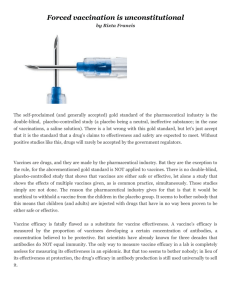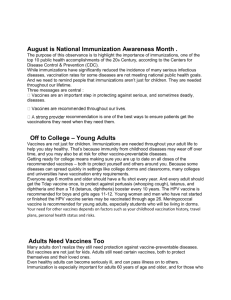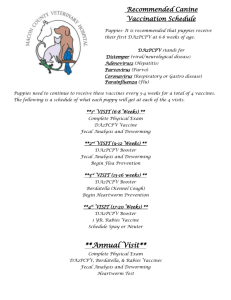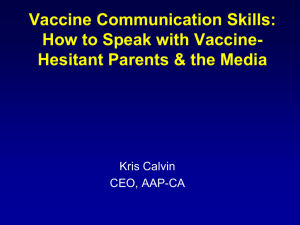114 - Practice Evolution
advertisement
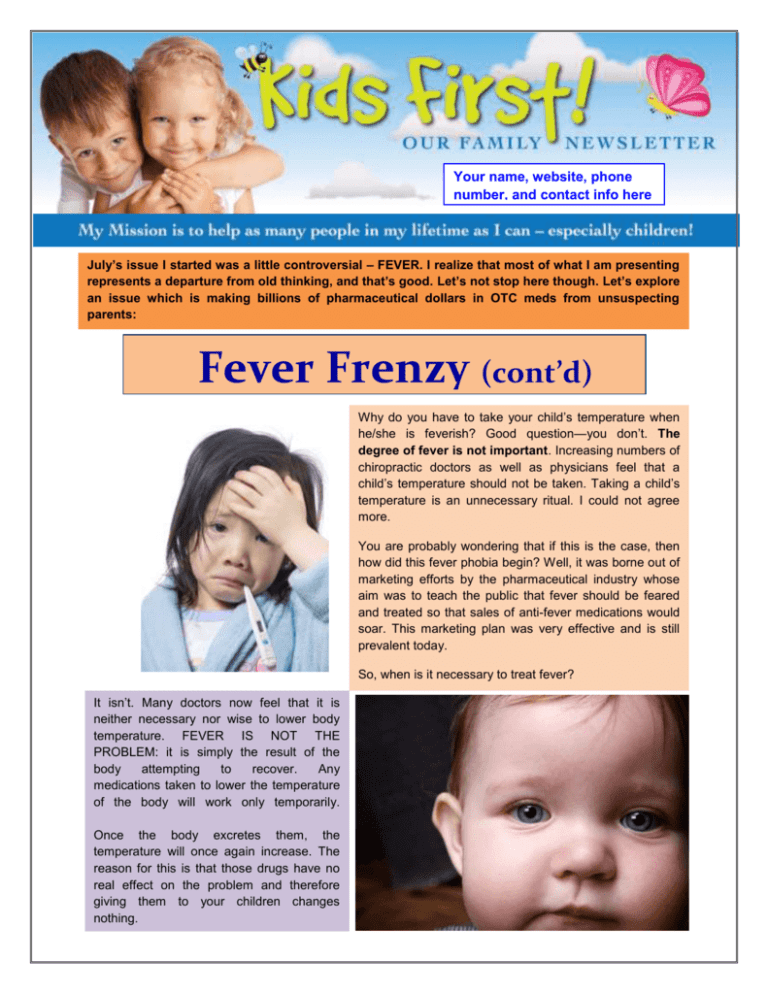
Your name, website, phone number, and contact info here July’s issue I started was a little controversial – FEVER. I realize that most of what I am presenting represents a departure from old thinking, and that’s good. Let’s not stop here though. Let’s explore an issue which is making billions of pharmaceutical dollars in OTC meds from unsuspecting parents: Fever Frenzy (cont’d) Why do you have to take your child’s temperature when he/she is feverish? Good question—you don’t. The degree of fever is not important. Increasing numbers of chiropractic doctors as well as physicians feel that a child’s temperature should not be taken. Taking a child’s temperature is an unnecessary ritual. I could not agree more. You are probably wondering that if this is the case, then how did this fever phobia begin? Well, it was borne out of marketing efforts by the pharmaceutical industry whose aim was to teach the public that fever should be feared and treated so that sales of anti-fever medications would soar. This marketing plan was very effective and is still prevalent today. So, when is it necessary to treat fever? It isn’t. Many doctors now feel that it is neither necessary nor wise to lower body temperature. FEVER IS NOT THE PROBLEM: it is simply the result of the body attempting to recover. Any medications taken to lower the temperature of the body will work only temporarily. Once the body excretes them, the temperature will once again increase. The reason for this is that those drugs have no real effect on the problem and therefore giving them to your children changes nothing. I would suggest that you have your child checked by a chiropractor like myself instead; the goal here would be to provide your child with the optimum function of the nervous system so that it can successfully deal with his/her “illness.” This may surprise you: I have just recently learned that back in the 1940’s in Davenport, Iowa, many chiropractors of the time were referred to as “flu doctors” and apparently, many patients would see a chiropractor in those days when they had the flu. They found that the length of time of their illness, its severity, and frequency was shortened sometimes up to 80 percent. If you must absolutely do “something” while your child is recovering, there are a number of natural health products found in health food stores that may help your child cope with this period of time when the body is “doing its thing.” There are, however, certain situations that warrant careful observation. If your child is under the age of one, and has a fever with the presence of any of the following signs, you should seek the advice of a health care professional: he/she is in severe pain and cannot be comforted, is anxious and or lethargic, whining continuously, cannot retain fluids and/or has diarrhea, has difficulty urinating, breathing, or swallowing, has an unexplained rash and has a rapid pulse rate. Any of the above or any combination thereof, indicates the body is having difficulty dealing with whatever it is handling, and I advise you to take a trip to your health care professional and seek his/her advice. All in all, fever should be viewed as a good sign - as the nervous system and immune system are doing exactly what they are designed to do. I suggest that the next time your child has a fever, understand the reason for it, but do not jump the gun and try to lower your child’s temperature; you may actually be delaying recovery! And please feel very welcome to ask me anytime! I am here to help! Cool kids in high school often have troubles later on in life In what is sure to be a controversial study based on your social standing as a teenager, a new report says being cool in high school might not be a good thing. The study, published in Child Development, tracked 184 kids starting at age 13 until they were 23. It measured “cool” by looking at certain behaviors associated with popular kids: “Displays of romantic behavior (like kissing or touching), deviant acts (like damaging their parent’s property or sneaking into a movie theatre without a ticket), or by associating themselves with more physically attractive friends,” Jezebel reported. Those behaviors, though, “predicted long-term difficulties in close relationships, as well as significant problems with alcohol and substance use, and elevated levels of criminal behavior,” said the study Source: Lisa Cianci – Orlando Sentinel The Belief in Vaccines Dr. Sherri Tenpenny, I always find it interesting that a discussion over the topic of vaccination can become "heated" and "volatile". Why is that?....would the same debate rage over an antibiotic or an antihypertensive medicine if there was evidence that it was causing harm? Highly doubtful. It would be removed promptly from the market if deaths resulted from its use. Even if deaths were suspected to be caused by a medication, we stop using it until we prove it is safe. Not so with a vaccine. We keep using it until we can "prove" it is causing harm. Why the double standard? The doublespeak occurs because vaccination is built around a "belief" system, and challenging the validity of vaccines challenges long-held foundational beliefs. We BELIEVE that vaccines are safe; we BELIEVE that vaccines are important for our health; we BELIEVE that vaccines will protect us from infection; we BELIEVE that vaccines were the reason infectious diseases decreased around the world. And we really want to BELIEVE that our doctor has read all the available information on vaccines--pro and con and that s/he is telling us the complete truth about vaccines...... However, belief is based on faith; not necessarily on fact. With only a cursory review of the literature and CDC documents, one will find the following facts: 1. No vaccine has ever been proven to be completely safe. Safety studies are small and only include "healthy" children. However, after a study is completed, vaccines are given to ALL children, regardless of underlying health conditions or genetic predispositions. We have a "one size fits all" national vaccination policy; one that does not allow for personal choice or individualized options; and one that has caused a myriad of health problems for many. 2. Observations for side effects continue for a maximum of 14 days during a "safety study". Complex problems involving the immune system can take weeks or even months to appear. This arbitrary 14 day cut off set by the FDA and the pharmaceutical industry stops the observation long before complications are likely to appear. This is the basis for their "vaccines are safe" mantra but the long term and relatively unknown complications from vaccines reveal that no vaccine is safe. 3. A vaccine "safety" study compares a new vaccine to a "placebo" to determine the safety of the new vaccine. When we examine the study a little more closely, we discover that the "placebo" is NOT a benign, inert substance, such as saline or water. The "placebo" is another vaccine with a "known safety profile." So if the new vaccine has the same side effects as the "placebo", the new vaccine is called "safe." 4. Vaccines are said to confer protection by causing the development of antibodies. However, there are many references in CDC documents (the Highest Authority in the land regarding vaccines) which reveal that antibodies don't necessarily protect us from infection. Here are a few examples from medical journals and CDC documents: Pertussis: “The findings of efficacy studies have not demonstrated a direct correlation between antibody response and protection against pertussis disease.” MMWR March 28, 1997/Vol.46/No. RR7, p.4 H. Flu (HiB): “The antibody contribution to clinical protection is unknown.” ---HibTITER package insert ”The precise level of antibody required for protection against HiB invasive disease is not clearly established.” http://www.cdc.gov/nip/publications/pink/hib.pdf. Smallpox: “Neutralizing antibodies are reported to reflect levels of protection, although this has not been validated in the field.” JAMA June 9,1999, Vol. 281, No. 22, p.3132 5. We want to "believe" that if we receive a vaccine, we will be protected from the infection. Several medical journal articles document that this is not necessarily so. Here are a few examples: Pertussis Infection in Fully Vaccinated Children in Day-Care Centers, Israel (Emerging Infectious Diseases Vol. 6, No. 5; Sep-Oct 2000) Pertussis in the Highly Vaccinated Population, The Netherlands (Emerging Infectious Diseases Vol. 6, No. 4 July-Aug 2000) Pertussis in North-West Western Australia in 1999; all vaccinated. (Communicable Diseases Intelligence 2000 Vol 2 4 No 12) The debate surrounding the use of vaccines goes back and forth with "data" and "studies" used to support both sides. But the bottom line is this: Vaccination has been "accepted" as safe, effective and protective for nearly 200 years. It is a "sacred cow" and with all "sacred cows", people react with a visceral response when someone suggests that the "cow" should be "sacrificed". There are many examples of this over the centuries: Copernicus who insisted that the Sun is the Center of the solar system and Semmelweiss who showed that doctors performing hand washing saved women's lives. Both men were ridiculed in their day. It is heresy to suggest that the "status quo" is wrong. Statistics have shown that when presented with a new, different, challenging idea, 96% of people will spend their time and energy defending their current beliefs and only 4% will embrace the idea as something to seriously consider. When you research vaccinations and the vaccine industry, you will find that your “foundational beliefs” regarding vaccines will be seriously challenged. When you begin to study the negative effects--both actual and theoretical--that vaccines have on the immune system, you will likely become part of the 4% who understand that “truth” about vaccines is not really “The Truth” and that the mandatory vaccination policies currently being enforced must be changed. 100 Ways to live to 100: 52. Routine mammograms (unless cancer is suspected) This blunderbuss approach, which uses x-rays to detect breast cancer, doesn’t see cancer at its earliest stages and fails to pick up aggressive tumors. For every women whose cancer is correctly detected, healthy women will go through unnecessary worry, further testing and even treatment before doctors realize they’ve been misled by a false-positive. Consider thermography instead. I will continue this topic over the next issues until we reach 100 points. Please enjoy!


